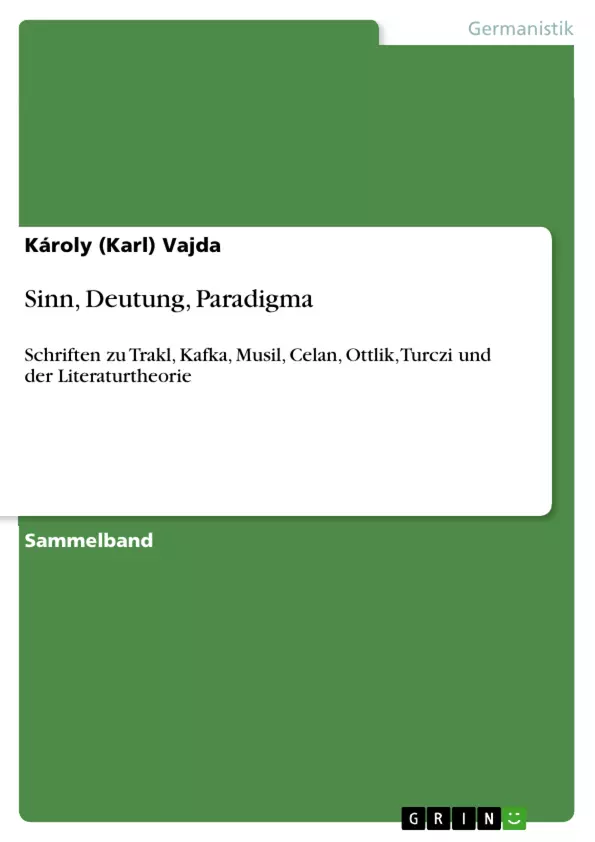In diesem Sammelband werden Texte von Trakl, Kafka, Musil, Celan, Géza Ottlik und István Turczi in bezug auf literaturtheoretische Grundsatzfragen interpretiert und zum Teil Wege einer Neuorientierung gezeigt. Versucht wird dabei die Sichtweise der literarischen Hermeneutik in Richtung ontologische Literaturtheorie zu erweitern.
Inhaltsverzeichnis
- Mythoepisches Sprechen in Celans „Tenebrae“
- Hermeneutische Glossen zu Georg Trakls „De profundis”
- Mehrdeutigkeiten in Kafkas „Der Wunsch Indianer zu werden“
- Lyrik, Liturgie und Literarizität in István Turczis „Ein Jahr“
- Literatur und Hermeneutik
- Die Struktur wissenschaftlicher Resolutionen I
- Die Struktur wissenschaftlicher Resolutionen II
- Die Aspekte der Poeto-Linguistik und der Horizont der Hermeneutik
- Literatur und Zeitlichkeit in Ottliks „Schule an der Grenze“
- Das Zeitproblem der Literatur bei Lessing und Herder
- Wissenschaftlich-klassizistische Zeitlichkeit der Gattungen bei Goethe
- Interpersonalität des Gedenkens in Robert Musils „Amsel“
Zielsetzung und Themenschwerpunkte
Der vorliegende Band befasst sich mit ontologischen und hermeneutischen Fragestellungen der Literaturtheorie und untersucht die philosophischen Grundlagen der Literaturinterpretation. Dabei werden zentrale Fragen der Poetologie und der metaphysischen Grundorientierung der Literaturtheorie in den Blick genommen.
- Die Rolle der Poetologie in der Literaturtheorie und ihre ontologischen Folgen
- Die Bedeutung des Positivismus, Strukturalismus und Poststrukturalismus für die Literaturtheorie
- Die ontologische Differenz in der Literaturwissenschaft
- Der ontologische Status literarischer Werke und ihre Beziehung zum Menschen
- Die Rezeption von Literatur und die Rolle des Rezipienten
Zusammenfassung der Kapitel
- Mythoepisches Sprechen in Celans „Tenebrae“: Analyse der sprachlichen Besonderheiten von Paul Celans Gedicht „Tenebrae“ und deren Beziehung zu mythischen Strukturen.
- Hermeneutische Glossen zu Georg Trakls „De profundis“: Interpretation von Georg Trakls Gedicht „De profundis“ unter Anwendung hermeneutischer Methoden.
- Mehrdeutigkeiten in Kafkas „Der Wunsch Indianer zu werden“: Untersuchung der Mehrdeutigkeit und der Interpretationsspielräume in Franz Kafkas Kurzgeschichte „Der Wunsch Indianer zu werden“.
- Lyrik, Liturgie und Literarizität in István Turczis „Ein Jahr“: Analyse der literarischen und liturgischen Elemente in István Turczis Roman „Ein Jahr“.
- Literatur und Hermeneutik: Diskussion der Beziehung zwischen Literatur und Hermeneutik und deren Bedeutung für die Literaturwissenschaft.
- Die Struktur wissenschaftlicher Resolutionen I: Analyse der Struktur und des Aufbaus wissenschaftlicher Arbeiten, Teil 1.
- Die Struktur wissenschaftlicher Resolutionen II: Analyse der Struktur und des Aufbaus wissenschaftlicher Arbeiten, Teil 2.
- Die Aspekte der Poeto-Linguistik und der Horizont der Hermeneutik: Untersuchung der Schnittmengen von Poetologie und Linguistik sowie deren Einordnung in den Horizont der Hermeneutik.
- Literatur und Zeitlichkeit in Ottliks „Schule an der Grenze“: Analyse der Zeitlichkeit und ihrer Darstellung in Géza Ottliks Roman „Schule an der Grenze“.
- Das Zeitproblem der Literatur bei Lessing und Herder: Untersuchung des Zeitproblems in der Literatur bei Gotthold Ephraim Lessing und Johann Gottfried Herder.
- Wissenschaftlich-klassizistische Zeitlichkeit der Gattungen bei Goethe: Analyse der Zeitlichkeit in den Gattungen der klassischen deutschen Literatur am Beispiel von Johann Wolfgang von Goethe.
- Interpersonalität des Gedenkens in Robert Musils „Amsel“: Interpretation von Robert Musils Erzählung „Amsel“ im Hinblick auf die Darstellung von Erinnerung und Interpersonalität.
Schlüsselwörter
Die zentralen Themen dieses Bandes sind Literaturtheorie, Hermeneutik, Ontologie, Poetologie, Interpretation, Textanalyse, Zeitlichkeit, Literatur und Gesellschaft. Die Studien befassen sich mit Werken von bedeutenden Autoren wie Paul Celan, Georg Trakl, Franz Kafka, Robert Musil, Géza Ottlik und István Turczi. Darüber hinaus werden grundlegende Fragen der wissenschaftlichen Methodik und der Struktur wissenschaftlicher Arbeiten beleuchtet.
- Quote paper
- Dr. Károly (Karl) Vajda (Author), 2010, Sinn, Deutung, Paradigma, Munich, GRIN Verlag, https://www.hausarbeiten.de/document/163886


